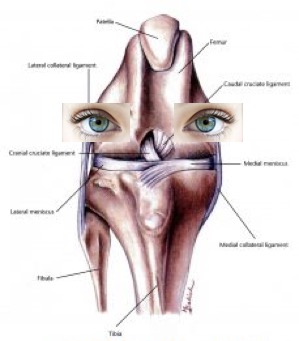Laurie's Blogs.
Jul 2017
The ACL, the brain, and the eyes!

ACL injuries are prevalent in both dogs and people! We are well aware of the issues as they present acutely after injury and post-operatively. Issues such as pain, swelling, gait modifications, osteoarthritis, and loss of strength to name a few. Trauma to the ACL has also been show to alter body awareness and reaction times. More and more human studies have reported unresolved neuroplastic changes after injury, reconstruction, and rehabilitation that may limit function and return to sports participation.
Anterior cruciate ligament (ACL) injury may result in neuroplastic changes due to lost mechanoreceptors of the ACL and compensations in neuromuscular control. Grooms et al did a study where they MRI’s ACL reconstructed (ACLR) patients and a cohort of normal participants as they repeatedly flexed and extended their knee. What they found was that participants who had undergone ACLR had increased activation in the contralateral motor cortex, lingual gyrus, and ipsilateral secondary somatosensory area and diminished activation in the ipsilateral motor cortex and cerebellum when compared to healthy matched controls.
What does that mean?

Well essentially, the ACLR participants were using (or trying to use) additional pathways (i.e. visual –motor in particular) in order to competently do the motor tasks, as their normal (sensory-motor pathways) were diminished.
(Check out the full paper and the full blog from where I learned of the original paper to understand the process in Anal-Retentive detail!)
Okay, Okay, I hear you saying. So, what do we do with this info?
1) Because we know the patient (dog or human) is now more reliant on visual postural cues, we would do well to get them to visually focus on something as they are doing a task. Fortunately for us in canine rehab, most of our exercise enticement also included cookies or treats… and this may actually be beneficial for visual-motor retraining!
2) I like to take dogs to an end-stage of rehab where I make them navigate objects while creating strong muscular contractions in the legs (i.e. playing tug of war through and obstacle course or while going back and forth over a plank.)
3) Educate the owner who has a dog post ACL repair or injury and concurrent vision issues, that he/she may have slower return to function or may have more long-term issues than a dog with full vision.
4) Practice more tasks while removing visual feedback. I like backing up exercises. Backing up straight line on a flat surface, then an unstable surface, then over obstacles, and then finally while backing up and stepping off of a surface onto an unstable surface (i.e. backing up from a platform onto an inflatable peanut or soft irregular surface.
I’m hoping this gives you some new knowledge and inspiration at the same time! Have fun challenging ALL of your patients’ systems in order to get them back to full functioning at whatever activity level they plan to get back to!
Resources:
Erson Religioso III, What is My Inferior Temporal Gyrus? And Why Haven’t I Up-Trained This Mother for my ACL Clients?
http://www.themanualtherapist.com/2017/04/what-is-my-inferior-temporal-gyrus-and.html
accessed June 21, 2017.
Grooms DR, et al. Neuroplasticty associated with anterior cruciate ligament reconstruction. J Orthop Sports Phys Ther. 2017 Mar;47(3):180-189.
https://www.ncbi.nlm.nih.gov/pubmed/27817301


